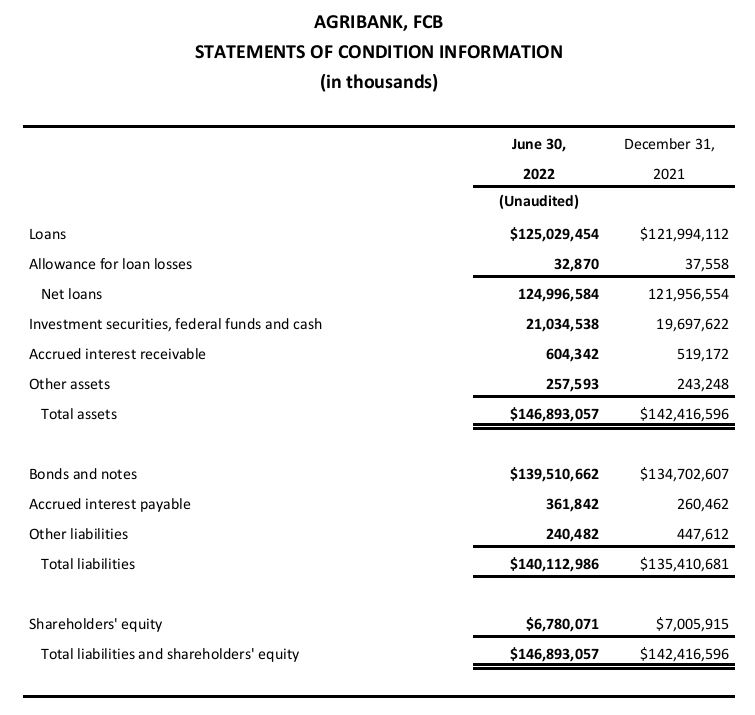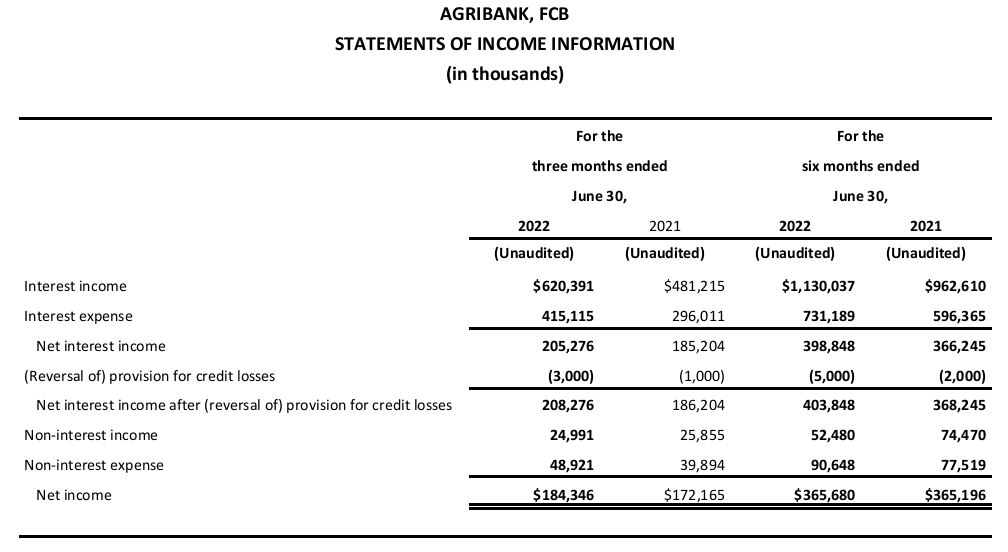ST. PAUL, Minn., August 8, 2022 – Today, St. Paul-based AgriBank announced financial results for the second quarter of 2022, with strong profitability, credit quality, and liquidity and capital.
Highlights:
- Profitability: Net income remained strong at $365.7 million for the six months ended June 30, 2022. AgriBank’s year-to-date return on assets (ROA) ratio of 51 basis points was above the target of 50 basis points.
- Credit quality: Total loan portfolio credit quality was strong, with 99.5 percent of loans classified as acceptable at June 30, 2022, compared to 98.3 percent at December 31, 2021.
- Liquidity and capital: End-of-the-quarter liquidity was 152 days, well above the regulatory requirement. Capital also remained well above the regulatory minimums and company targets.
“AgriBank’s key financial measures remained strong through the second quarter of 2022,” said Jeffrey Swanhorst, AgriBank chief executive officer. “Increases in loan volume and credit quality continued to drive strong profitability. Our steady business and financial performance reflects the enduring strength of the Farm Credit lenders we fund as well as that of Farm Credit borrowers, even in the face of economic uncertainty.”
Year-to-date 2022 Results of Operations
Net interest income was $398.8 million for the six months ended June 30, 2022, an increase of $32.6 million, or 8.9 percent, compared to the same period of the prior year. Net interest income increased mainly due to continued increases in both wholesale and retail loan volume, specifically in asset pool programs.
Non-interest income was $52.5 million for the six months ended June 30, 2022, a decrease of $22.0 million, or 29.5 percent, compared to the same period of the prior year. The decline was primarily driven by lower loan prepayment and conversion fees, partially offset by increased mineral income.
Non-interest expense increased $13.1 million, or 16.9 percent, for the six months ended June 30, 2022 compared to the same period of the prior year. The increase was primarily driven by an increase in loan servicing fees related to pool programs.
Loan Portfolio
Total loans were $125.0 billion at June 30, 2022, an increase of $3.0 billion, or 2.5 percent, compared to December 31, 2021. This increase, mainly in AgriBank’s wholesale portfolio, was primarily driven by a rise in agribusiness and real estate mortgage volume throughout the AgriBank District, partially offset by declines in production and intermediate-term volume. Agribusiness volume increases were related to growth in capital markets lending at several District Associations, specifically in the grain sector, during the first half of 2022. These increases were partially offset by seasonal repayments of operating lines in the second quarter, which were larger and came later than normal following the spring commodity price run-ups. Additionally, real estate mortgage volume increased at District Associations due to continued demand for lower fixed rates in the first quarter of 2022, prior to the quickly rising rates in the second quarter. Offsetting these increases, production and intermediate-term volume decreased related to seasonal tax-planning growth in December, followed by repayments in January.
AgriBank’s credit quality reflects the overall financial strength of District Associations and their underlying portfolios of retail loans. AgriBank’s portfolio was composed of 99.5 percent loans classified as acceptable as of June 30, 2022, compared to 98.3 percent at December 31, 2021. Loans classified as acceptable represent the highest-quality assets. The credit quality of AgriBank’s retail loan portfolio increased to 95.6 percent classified as acceptable at June 30, 2022, compared to 95.4 percent acceptable at December 31, 2021. The improvement in the acceptable percentage of the retail portfolio was related to loan purchases in several pool programs. Additionally, continued strong net farm income and stable farm sector working capital positively impacted the acceptable percentage.
Agricultural Conditions
The U.S. Department of Agriculture’s Economic Research Service (USDA-ERS) released its initial forecast of the U.S. aggregate farm income and financial conditions for 2022 on February 4, 2022 using price and production forecasts from the January 2022 World Agricultural Supply and Demand Estimates (WASDE) report. The initial forecast put 2022 net farm income (NFI) down $5.4 billion, or 4.5 percent, from the $119.1 billion 2021 NFI forecast. If realized at $113.7 billion, the 2022 NFI projection would be the third highest level ever in nominal dollars, trailing only 2021 and 2013. The lower 2022 NFI forecast is largely driven by an expected $15.4 billion, or 56.8 percent, decline in direct government payments paired with a $20.1 billion, or 5.1 percent, increase in total production expenses. These two factors more than offset the $29.3 billion forecasted increase in cash receipts from crop and animal/animal product sales. Rapidly evolving market conditions and geopolitical events since the February 2022 USDA-ERS forecast release will likely result in significant revisions to the USDA-ERS farm finance forecasts in its September 1, 2022 forecast update.
Despite all the challenges and uncertainty in markets the past few years, the U.S. agriculture sector is positioned well in 2022, and farm balance sheets are generally strong. Many factors, including weather, trade, government policy, global agricultural production levels, and pathogenic outbreaks in livestock and poultry, may keep agriculture market volatility elevated for the next 12 months. Implementation of cost-saving technologies, marketing methods and risk management strategies will continue to cause a wide range of results among the respective agricultural producers.
Capital Resources and Liquidity
Total capital remained very strong at $6.8 billion as of June 30, 2022, a decrease of $225.8 million compared to December 31, 2021. While net income and net stock issuances positively impacted shareholders’ equity, these increases were more than offset by unrealized investment losses, primarily on U.S. treasuries and U.S. government guaranteed mortgage-backed securities, related to the rapid increase in interest rates. AgriBank exceeded all regulatory capital minimum requirements, including additional regulatory buffers.
Cash and investments totaled $21.0 billion and $19.7 billion at June 30, 2022 and December 31, 2021, respectively. AgriBank’s end-of-the-period liquidity position represented 152 days coverage of maturing debt obligations, which supports operational demands, and was well above the 90-day minimum established by AgriBank’s regulator.
About AgriBank
AgriBank is part of the customer-owned, nationwide Farm Credit System. Under Farm Credit’s cooperative structure, AgriBank is primarily owned by local Farm Credit Associations, which provide financial products and services to rural communities and agriculture. AgriBank obtains funds and provides funding and financial solutions to those Associations. The AgriBank District covers a 15-state area stretching from Wyoming to Ohio and Minnesota to Arkansas. For more information, please visit www.AgriBank.com.
Forward-Looking Statements
Any forward-looking statements in this press release are based on current expectations and are subject to uncertainty and changes in circumstances. Actual results may differ materially from expectations due to a number of risks and uncertainties. More information about these risks and uncertainties is contained in AgriBank’s annual report, which is available no later than 75 days following the end of the year. AgriBank undertakes no duty to update or revise any forward-looking statements, whether as a result of new information, future events or otherwise.




